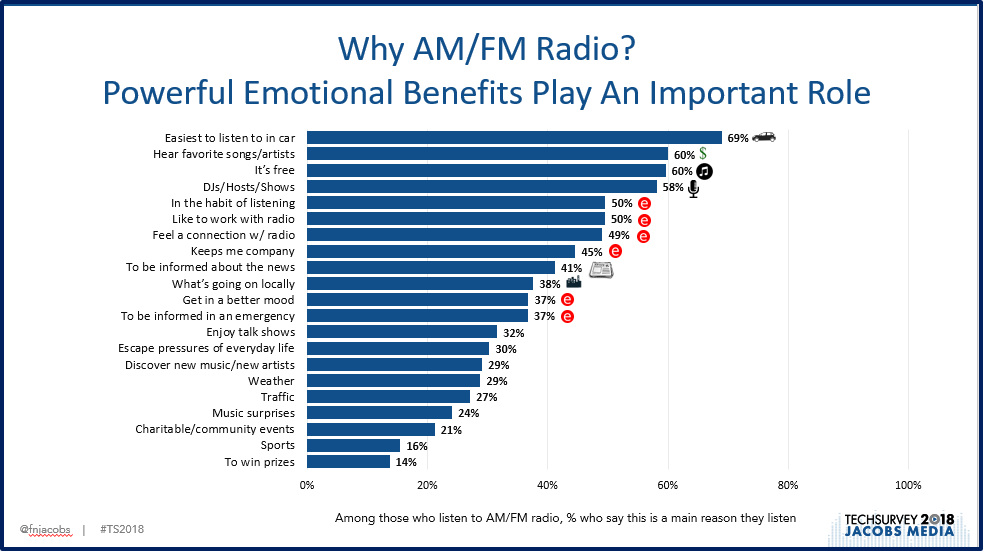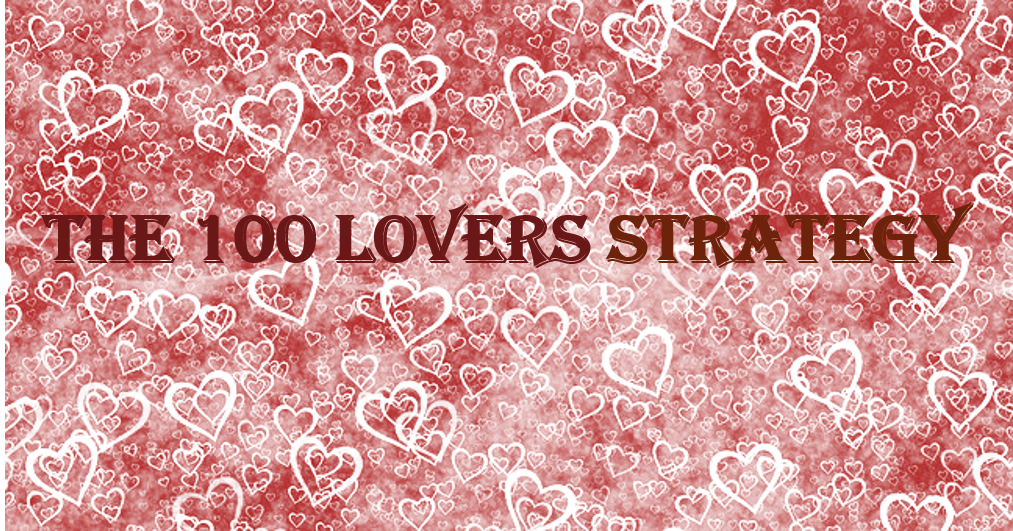 Now that I’ve presented the new Techsurvey 2018 a few times, you get a sense for which findings resonate.
Now that I’ve presented the new Techsurvey 2018 a few times, you get a sense for which findings resonate.
I saw this head-on at the Worldwide Radio Summit where a packed room bobbed and weaved as I presented this year’s key findings. And one surefire way you can determine which chart and graphs reach out and grab observers is to watch the ones that attract the most mobile phone camera action.
We’ve asked a series of new questions this year – deeper dives into podcasting, smart speakers, and satellite radio. And the findings are informative, provocative, and in some cases, breakthrough. But one of the old standbys – why respondents enjoy listening to broadcast radio – continues to produce photogenic charts.
It’s an interesting question because so many other facets of the survey deal with new technology and platforms – smart speakers, podcasts, streaming video, and smartwatches. So, what is it about broadcast radio that keeps consumers coming back day in and day out amidst all this new technology?
To find out, Techsusrvey’s audience of mostly core radio listeners point to a variety of different factors. Radio is free, plays great music, and features iconic personalities.
But then there are the “emotional benefits” that are part of broadcast radio’s fundamental appeal. You can see them designated with the round red Es on the chart below:

For many, radio is part of their daily routine, it’s a companion, it’s a mood elevator, and it’s a way to keep up with the goings-on in their communities. Those emotional underpinnings are an important part of the connection audiences have with their favorite radio stations.
Interestingly, they rarely find their way into liners and positioners as most radio marketers opt for language that deals in superlatives that are format related (“The News Authority,” “The Most Music With Less Talk & Commercials,” etc.). Yet, it’s those little red E benefits that pack a more powerful bunch, connecting with audiences in emotional ways.
It’s noteworthy that most consumer-generated Spotify playlist names tend to be about moods, attitudes, and situations, rather than music genres. That’s how most people connect with music, making it associative with the things they do and the emotions they feel.
As it turns out, many of these same attitudinal attributes that set broadcast radio apart are similar to the ways in which other brands bond with their core fans. A recent story in the Harvard Business Review’s “Customers’ column examines how both Airbnb and Strava ( a mobile app that racks cyclists and other athletes) have found new and novel ways to connect with their fans.
A core component of building an emotioinal brand is “The 100 Lovers Strategy.” As Paul Graham of the funding incubator Y Combinator explains, the key is to leverage your fans’ love for your product or service.
 It starts with identifying a group of users who are passionate about your brand – or in our case, your radio station. Here’s how Graham explains it:
It starts with identifying a group of users who are passionate about your brand – or in our case, your radio station. Here’s how Graham explains it:
“It’s better to have 100 people that love you than a million people that just sort of like you. Find 100 people that love you.”
And from there, brands can use the power, energy, creativity and passion of these fans to generate content and provide insights about what makes the audience and the brand tick.
Like in radio, that often translates into tapping into a the emotional fiber that explains with how people use and connect with the brand.
In Strava’s case, the “emotional layer” is all about the fire to perform at a higher level with friendly ineraction with other cyclists. That led to the formation of small groups (called “mobs”), accompanying marketing discounts, and user creation of web content – all outgrowths of that emotional connection with the brand.
The article goes onto explain how these learnings helped separate Strava from some of the big players in the space, like Nike and Garmin. The “mobs”  became comfortable with offering constant feedback, as well as recommending Strava to other athletes.
became comfortable with offering constant feedback, as well as recommending Strava to other athletes.
The authors make the point that “100 lovers can quickly allow a company to conquer the world.” That’s something our radio stations should aspire to achieve.
While the size of your cume matters, especially in the pursuit of ratings, it’s those core fans who can transform a radio station into a powerful “emotional brand.” And those of you in PPM markets know how transient cumers can be, especially in passive listening situations.
That’s part of the secret behind Techsurvey – focusing on an audience that has already bought into broadcast radio and the more than 560 stakeholder stations that participated in this amazing research process.
Core audience matters. Not just because they listen more, but because they want to help you build your brand. And that’s the backbone of Techsurvey, a research study that’s focused on many of these “lovers” – the heavy users who extol the virtues of your radio station to others. We see that routinely show up in our Net Promoter scores – a true recommendation measure that separates great stations from the also-rans.
Unlike the hundreds of syndicated research studies that report on broad trends across the U.S. or even the globe, Techsurvey’s local flavor and its ability to connect radio stations to its fans is its “secret sauce.”
It’s how “emotional brands” are built.
A Techsurvey 2018 deck will be available later this week. And an all-industry free webinar will be scheduled for later this month.
- What To Do If Your Radio Station Goes Through A Midlife Crisis - April 25, 2025
- A 2020 Lesson?It Could All Be Gone In A Flash - April 24, 2025
- How AI Can Give Radio Personalities More…PERSONALITY - April 23, 2025




Very insightful! In the old days we just focused mainly on time, temp, and local information. It is good to know that listeners feel a connection with the people on the air and the station(s) they listen to on a regular basis. Radio is simply one to one communication.
Jeff, check out David Manzi’s comment. In some ways, time & temp has become code for a mindless DJ giving out useless info we all have readily available on our phones or dashboards. Delivered in context, however, this info can still relate and resonate. You are correct about the listener connection to people on the air. It very much matters, evene though there’s less of it than ever before. Thanks for the comment.
Interesting comment from Jeff Akin about “time and temp.” I’ve been thinking recently about how, sometime back, that became a negative phrase–the jock who just gave time and temp–similar to the sitcom TV anchor whose soul talent was to look nice while reading a teleprompter. But personally, I think the loss of “time and temp” has been detrimental to the industry. I heard a break recently on a major rock station that was so bland–not tied to anything played on the air or anything happening in the news–followed by a gap between the deejay and the spot that followed that you could drive a truck through, that you just knew you were listening to a guy who recorded that track knowing he would have no idea in the world when it might play and next to what. At least the “time and temp” jocks told me something helpful to know–while also sending the message that someone in my community cared about my community. Radio–as this article does a great job pointing out–will need to do a better job of showing it cares for its listeners if it wants its listeners to care about radio.
We’ve been developing imaging that helps stations bond emotionally with listeners, instead of the usual positioning statements and bragging. They are little stories about the listener.
So far, we’ve created some for classic rock and classic country. Contact me if you’d like to hear some and I’ll send them along. I’d be very interested in your feedback.
I’d be curious to hear some of your stuff. We’re an A/C focused on at work listening with an in market competitor that is trying to do the same thing.
Dave
Dave,
Email me [email protected].
Jeffrey Hedquist
RE: David Manzi “Time & Temp”
Many of our industry experts began preaching, “there’s no reason to give time or weather on the radio because EVERYBODY has a phone to instantly get that information.”
Well, no they don’t ALL have a screen within their view. Because they are busy or distracted by singing along with their favorite song and the radio host’s last pseudo-intellectual and hysterical sexual innuendo. Many listeners appreciate a gentle tap on the shoulder to remind them. (“Oh crap, it’s 6:42 and I haven’t fed the dog yet!”)(“it’s gonna be 87 today? I can’t wear my Class of ’72 letterman’s jacket”)
I’ll even go old-school and say some listeners still want/need to know what DAY it is. And possibly the date also. Did you ever forget an event because you thought Cinco de Mayo landed on Monday the 7th this year? Of course you did.
Whether they need it or not, what do you lose by eliminating it from your backsell, 3 seconds? As David correctly said, you are telling your listener that you are present and (a)live and you care just a bit more than Pandora. Or your competitors who run tracked.
Bobby, great to hear you weigh in on this. Couldn’t agree more. It’s wasted information if it’s thrown away like it doesn’t matter. It’s good content if it’s relatable and resonates with your audience. And by the way, I ALWAYS know what day it is.